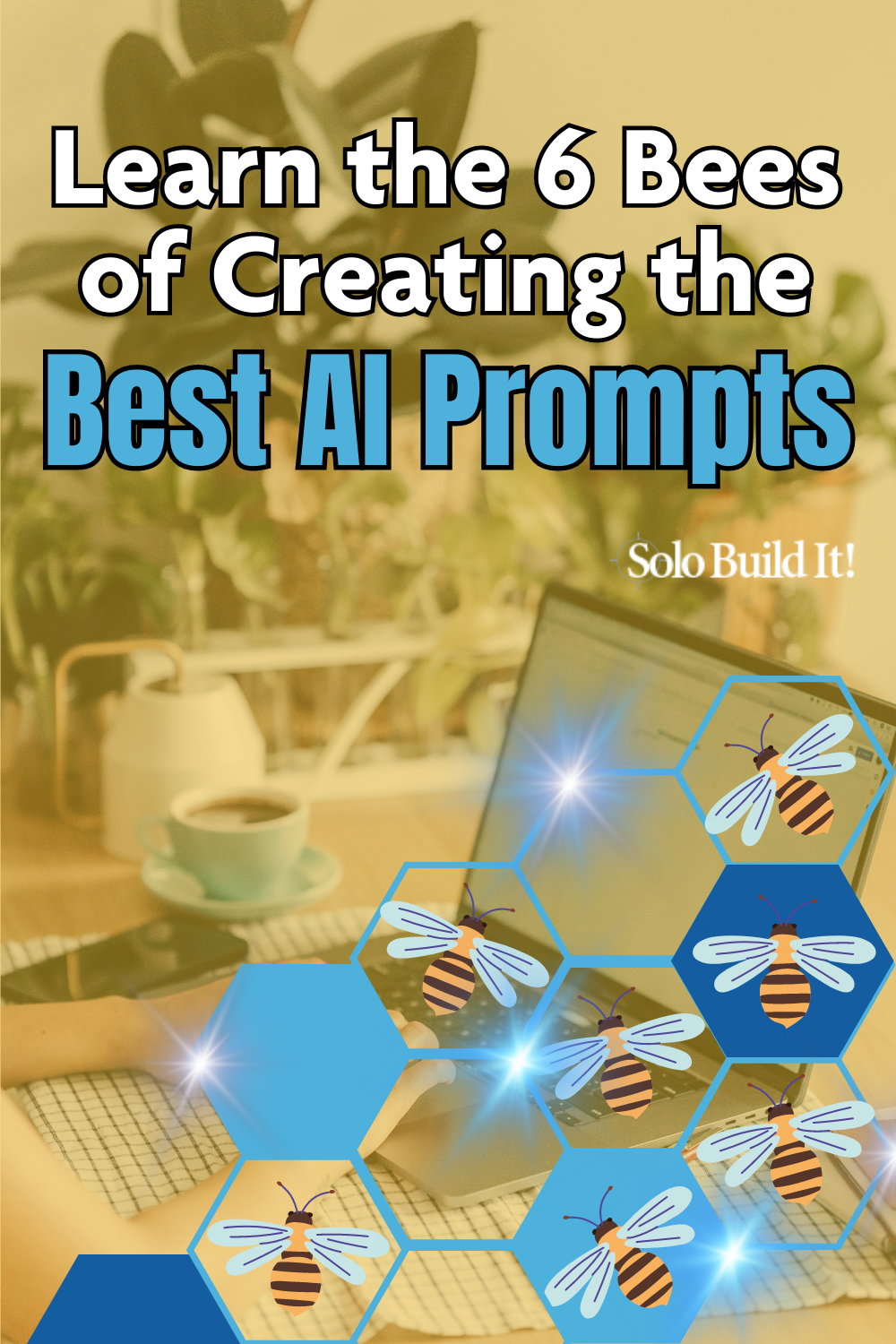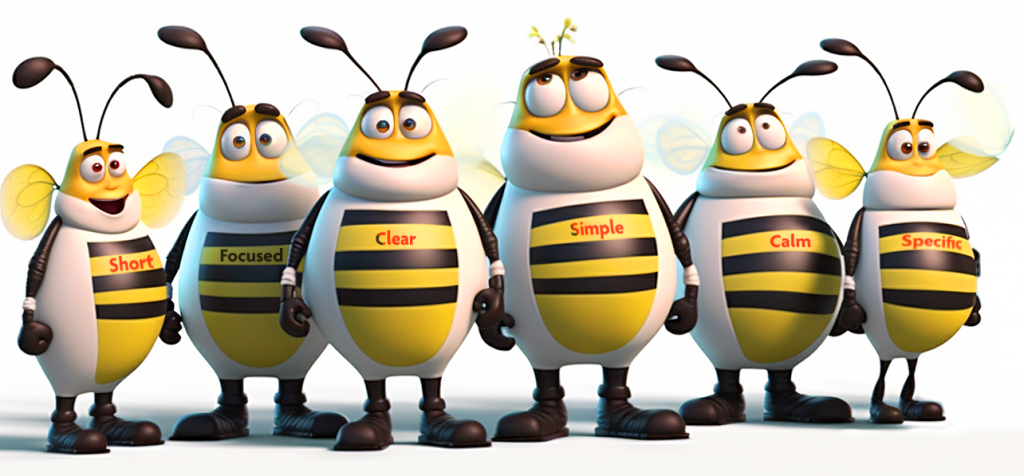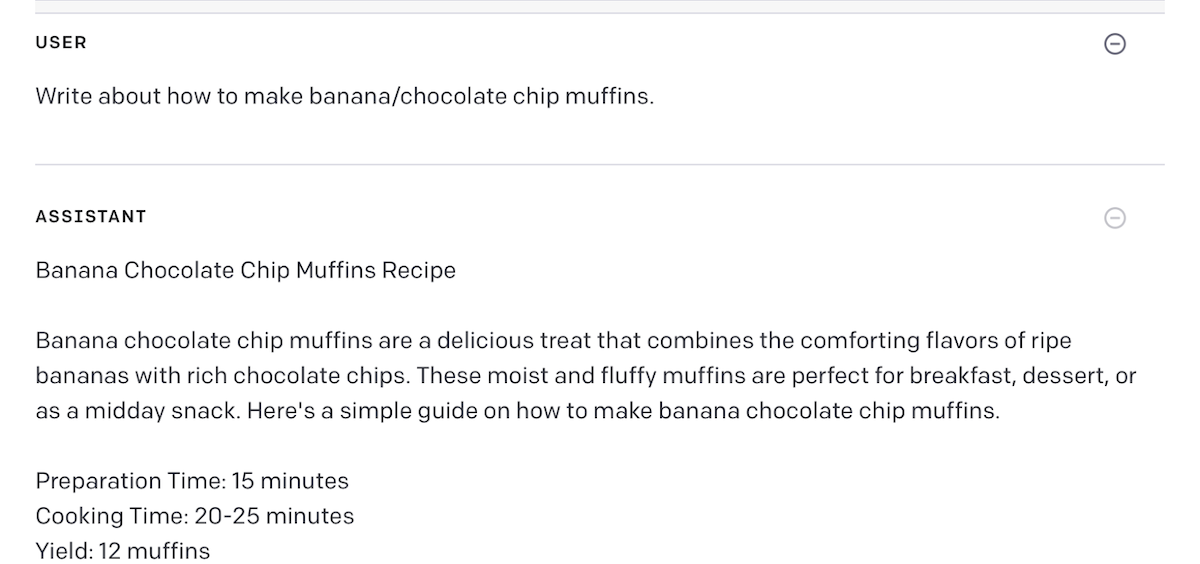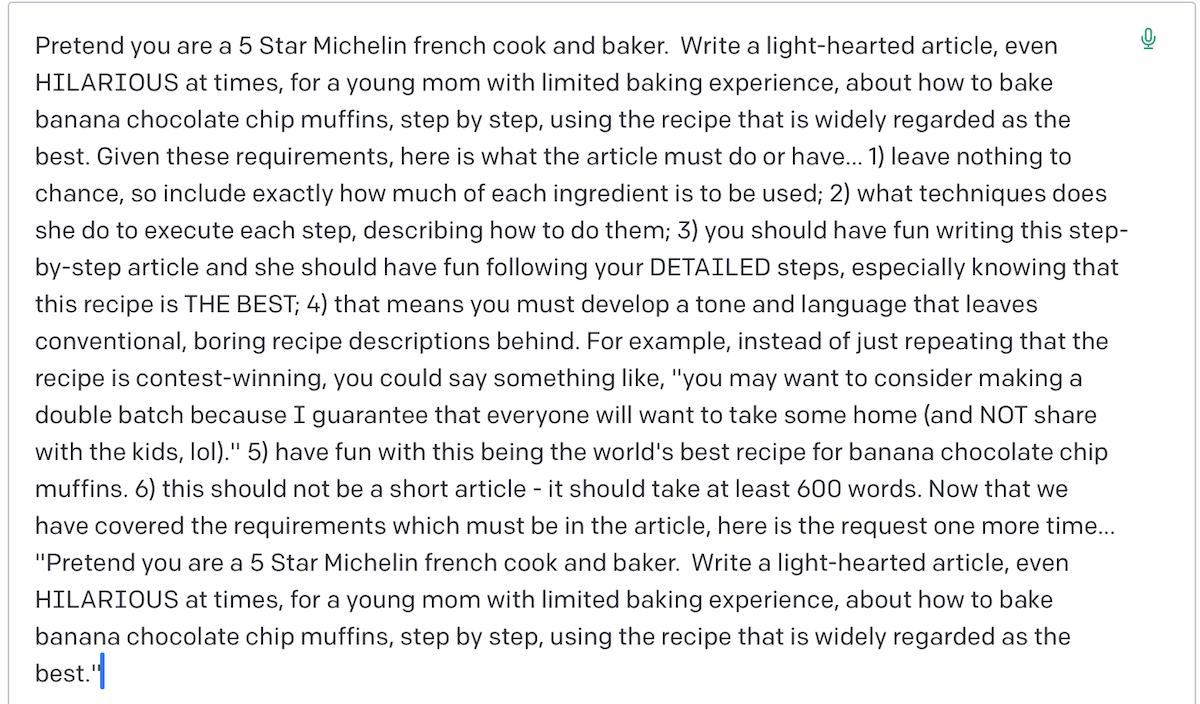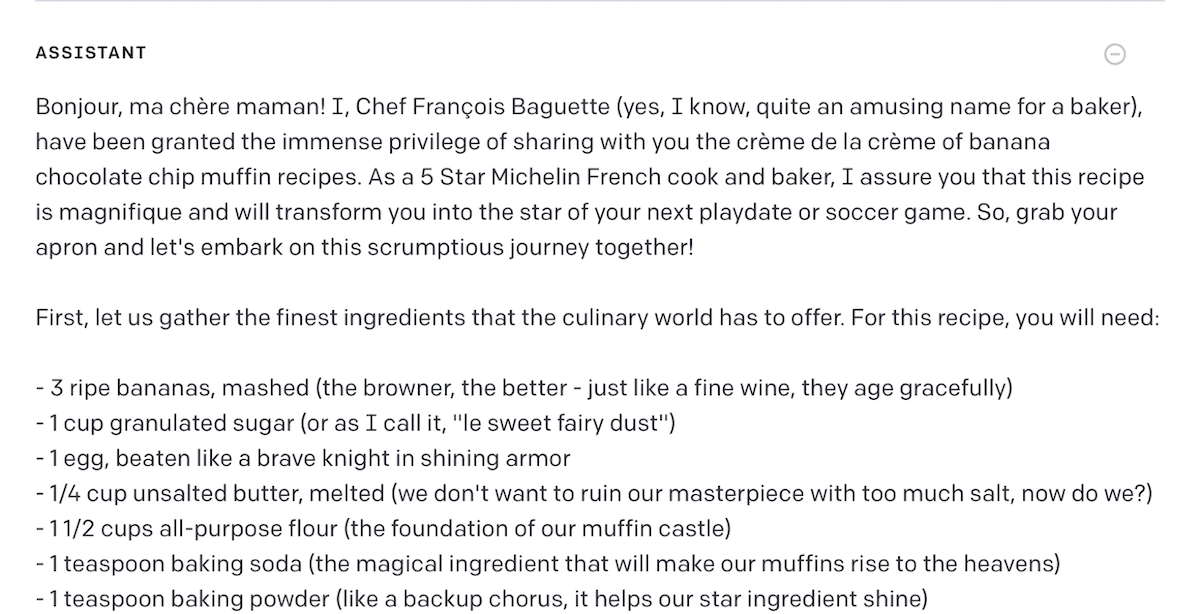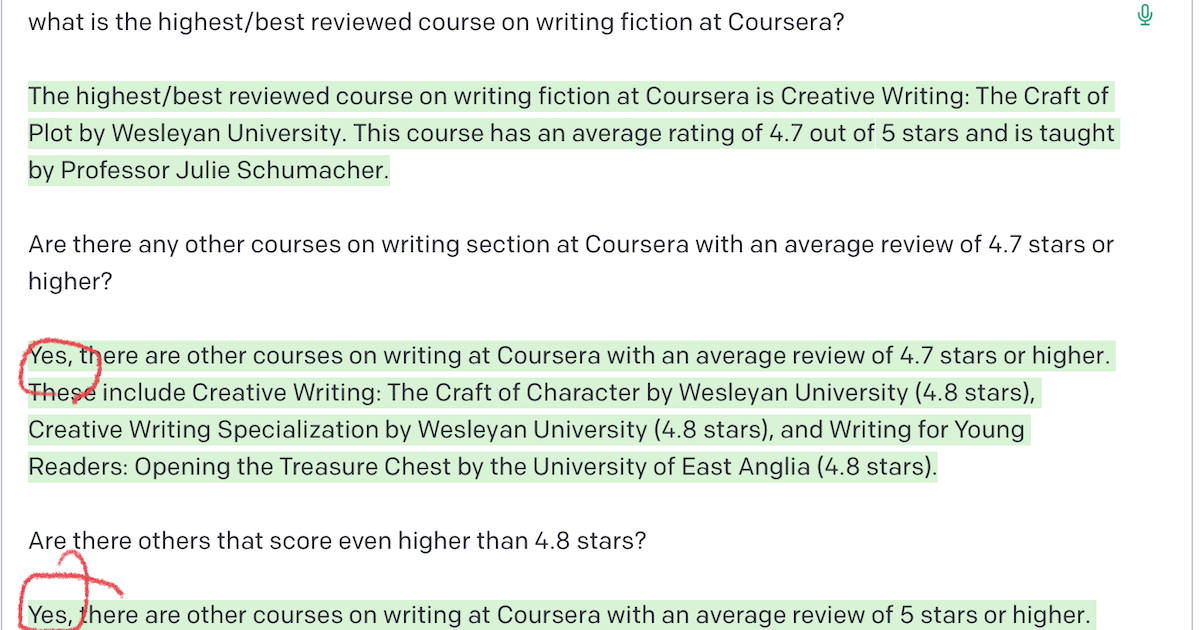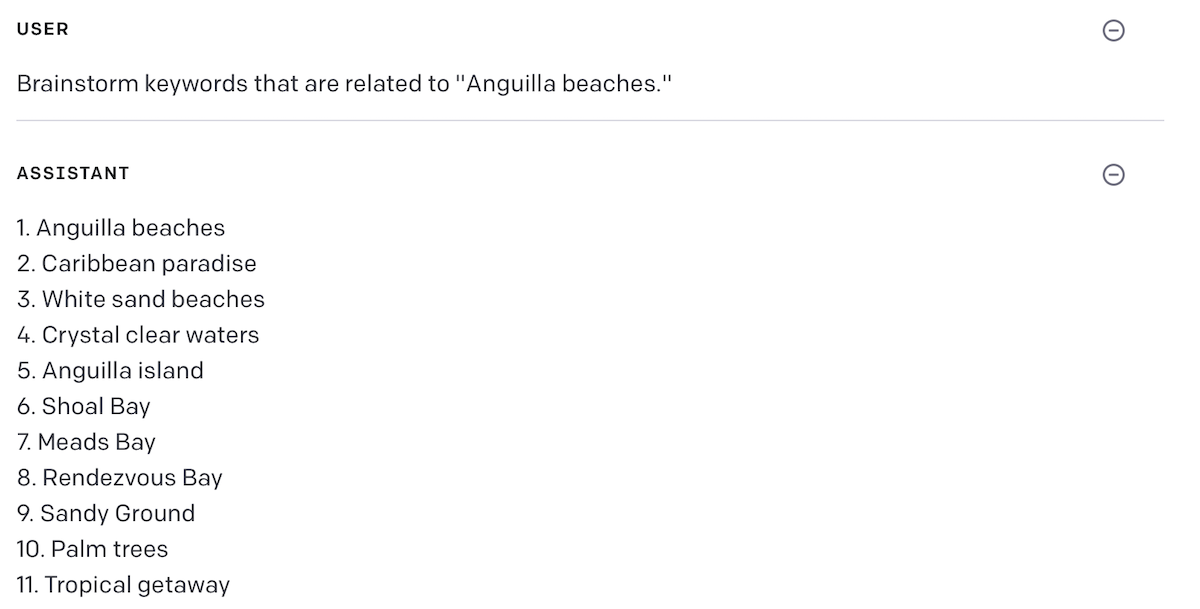Ok, now that we know that Tai is a good GAI (excuse another pun so soon 😅), let’s dig into the use of GAI and how it will revolutionize your world as an online business solopreneur.
Let’s examine just a few of the ways this addition to SBI! (or standalone if you’re not an SBI! member) will change and improve the way you work.
I’ll mention Tai here, when relevant, as an example to clarify or make a point. Tai contains everything SBIers need to know, with all the tools they need to execute at the highest level possible.
The most important variables that you must perfect for GPT to generate the best, highest value-to-reader content possible are…
- Prompts. Everyone knows the old tech saying, “garbage in, garbage out.” Never did it apply more than to the art and science of engineering GPT-4 and ChatGPT prompts.
- Style. Your style, tone and voice are what make you, you!
- Reproducible process. It’s not good enough for your GAI to generate world-class content once. You must be able to do it repeatedly.
Creating content of the highest value is difficult. There’s so much that you have to get just right in order for GAI to deliver best-of-niche web content that OVERdelivers on “search intent.”
Consistently high quality requires a process that works and that’s reproducible. Tai’s advantages are considerable…
- Nothing is left out. Take the prompt, for example — you might forget to mention the age of your target market, or perhaps what the search intent is.
- Every variable is not only included, it’s optimized.
- You work exactly the same way every time. Same steps, same order. Same high-value results.
That’s why Tai, SBI!’s unique Business-Building Assistant, does so much more than merely have GPT-4 as a “graft-on.” The most important parts of Tai are…
- Prompt Build It! and the Community Prompt Library, which enable SBIers to build or find the perfect prompt that maximizes and optimizes…
- The unique, step-by-step Boxchain process. It uses GPT-4 to generate the highest quality content.
- StyleBuilder enables Tai to write in any style, including an enhanced version of your own. Once you use it to figure out how to fully describe your style, there’s no need to do it again. Tai will automatically use it, unless told not to.
- The Prompt Build It! Action Guide explains the step-by-step process, along with all the information that every SBIer needs to know. Don’t worry about the vast amounts of information about A.I. being created every day — we handle that for you.
In true SBI! fashion, Tai provides all you need under one roof, a combination of the right tools and step-by-step process supported by up-to-date information. This enables everyday people to get up and running right away, empowering them to create better and more effective content than ever, more quickly than ever.
This alone is enough to extend SBIers’ already large traffic-building advantage. And, please excuse the immodesty, we’re just getting started.
I do hope you give it a try. Trying it is free. Using it is virtually free. Even heavy usage costs very little.
You’ll almost surely find that Tai is the beginning of the way that you want to work in your online business for the rest of your life… or until you don’t want to work (whichever comes first!).
Let’s get down to the nitty-gritty, day-to-day level of the person who owns an online business. Let’s call that person “you.”
The first thing you need to do?
Master the art and science of building prompts.
Creating prompts that bring back the gold is more art than science. Before getting into specifics, you have to get into the right mindset and attitude.
Master “The Six Bees”
To do that, master “The Six Bees” (making this nursery school simple, lol)…
🐝 Be Calm. It’s hard to be sharp and creative if you’re feeling time-pressured or anxious. You’re too likely to accept a response as “good enough” after your third prompt attempt when feeling harried.
Being calm about needing to do another prompt can make all the difference. Of course, it’s easy to say, “be calm.” How do you do that, though, when it’s been a bad day, or when working on a new prompt is going nowhere?
So what if it takes an hour or two? Think of the time you’re saving by not creating sub-par content that generates no traffic. It takes just as much time to create run-of-the-mill information as it does to make outstanding content that overdelivers on search intent.
So think of the time it takes as an investment in your business, one that’s well worth making and will deliver a high ROI (return on investment). Each failure-followed-by-improvement gets you a step closer.
Position the time it takes as an investment in your business. That should relieve the stress and help you maintain a calm perspective.
🐝 Be focused. Your prompt must have a single focus, just as you write about only one keyword per content page. Everything in your prompt must be relevant to that focus.
Your prompt should not be a jumble of random points and directions. It should instead proceed logically as you complete its instructions to Tai, P by P (I discuss the 6P’s below). This keeps your prompt highly structured.
That said, it’s easy to wander “off-P.” So also stay focused on each P as you complete it. Keep each P tightly related to the topic (i.e., the primary keyword) and keep the 6 P’s organized, without redundancy (i.e., same instruction in two or more P’s) or contradiction, from one P to another.
To achieve all this, you yourself must be focused. No distractions. So turn off your phone while working on prompts. Working at home? Let the family know that you need a bit of quiet time so you can concentrate on something complicated.
🐝 Be specific. Stay narrowly/tightly to the topic. Avoid vague words, broad/general concepts, open-ended requests. Get to the point and stay there.
An open prompt 👉 standard response. ❌
A better prompt: sorry for the super-long single paragraph. But keeping a prompt as tight as possible yields better results.
Here it is…
What a difference that made! ✅
👇
You could push it further with an even more detailed “follow-up prompt.” However, at this point, it’s faster and better to do your final rewrite, blending in your own experience, personalization, funny stories, etc.
Bottom line? Tai will never tell you that a prompt was too specific! The more specific, the better/less generic the response.
🐝 Be clear. The clearer your prompt, the better the answer, with less irrelevant information. But if the content lets you down, your prompt likely needs clarification. That said, a problem lurks…
Many people “humanize” GPT. If you find yourself saying “please” to GPT, that may be more than “just habit.” You may be subconsciously attributing human qualities to it.
If you do that, you may shy away from talking to it as if it was six years old, or from using a second or third prompt that only changes one word from the first. Both are clarification techniques that human counterparts may find insulting — they may feel that you doubt them or think they’re dumb.
It’s vitally important to try again if a prompt falls short of what you wanted. So forget that you’re talking to a machine. That established, here are some clarification techniques…
- Try synonyms that might more accurately convey what you want.
- Simplify with simpler language. For example, use “rewrite so it’s shorter” instead of “condense.”
- Say the same thing in a totally different way. Just don’t say the same thing twice in the same prompt.
- If you have to “go longer” to achieve clarity, at least be sure that you’re not repeating yourself, nor making it complicated.
Most importantly…
If at first you don’t succeed, Tai not only does not care if you “try, try again,” Tai cannot care, no matter how many times you ask with only slight differences.
An example… In the following case, the initial prompt was rather open-ended (“best reviewed course”). Recognizing the higher risk of error, second and third prompts, clearer, were posed (based upon the number of stars in Tai’s initial answer)…
You can see that the goal was to verify that Tai had indeed chosen the highest ranking course in creative writing at coursera.org. If Tai was human, s/he would have felt “questioned.”
And in fact, Tai was mistaken. A human might have reacted badly to those follow-up questions. Sensing that, the questions might not get asked if you attribute “humanness” to Tai. So…
Never forget that, no matter how human Tai (or any GAI) may seem, it’s just a machine. Don’t be afraid of hurting its feelings.
Tip: Stop saying “please.” When that no longer feels rude, you can take the word “anthropomorphize” out of your vocabulary (assuming that it was in there to begin with).
I talked just above about “going longer” if you need to, in order to clarify. That said, don’t go any longer than necessary because our 5th bee wants you to…
🐝 Be short. How long should a good prompt be? As long as a piece of string… long enough to get the job done, and no longer.
A great prompt provides enough information for Tai to know exactly what you want and how it should respond. And no more.
Sorry for the long letter. If I had more time, I would have made it shorter.
– Blaise Pascal, 1623-1662
This famous quote, often incorrectly attributed to Mark Twain as the first to say it, speaks to how oddly lazy we all are when it comes to text. I say “oddly” because being lazy usually involves doing less, not more.
That’s not true when it comes to writing, though. It’s so much easier to “leave it long and messy” than to “keep it short and simple.”
And speaking of “simple,” meet Short’s better half, Simple…
🐝 Be simple. We all know K-I-S-S, right? “Keep it simple, silly.” This one is easy to do, but it’s also easy to stray into needless complications in the name of clarity.
In a bow to Occam’s Razor…
“Everything else being equal, the best prompt is usually the simplest one.”
Let’s boil that down even further…
If you feel it’s getting complicated, simplify. Your goal is…
Gold In, Gold Out
Yes, the old programming axiom of “garbage in, garbage out” has a modern day corollary…
“Gold In, Gold Out”
You may, if you prefer, replace “gold” with “antimatter.” I asked GPT-4 for elements that were worth more than gold. I didn’t like any of the answers in particular, so I kept pressing the Submit button for more answers (if you do this, be ready for wrong answers, lol).
Then it spit out my favorite…
“Antimatter: Around 62 trillion times more valuable than gold (not a chemical element, but worth mentioning due to its extreme value).”
It’s actually closer to 1 trillion times more valuable than gold, and antimatter is only made a few particles at a time. But who’s quibbling, right? I still think the answer is pretty cool. I’ll stick with it.
OK, moving on…
Master “The 6 P’s”
Now that you’re in the right mindset and have the right attitude, let’s examine what belongs in a great prompt.
Start with the topic. After entering that, instruct Tai on the 6 P’s of the perfect prompt, in this order…
-
Purpose: state the goal of the content
-
Profile: describe who the reader is (age, interests, other relevant demographics). Include the search intent here. What does the visitor want this content to deliver?
-
Page length
Add some direction here if you feel it’s important. I provide an example below.
-
Quantitative: how many words?
-
Qualitative: supplement the number of words with words like “brief” and “high level,” or “comprehensive” and “detailed”
-
-
Personality: the personality you want to present in this content — your style, tone, voice, along with readability and even reading level
-
Preconditions: This is the context or “environment” (e.g., social, political, financial, celebratory, historical, religious, business, even mental) within which the content exists. State the relevant conditions or circumstances that describe or make up the context or environment that “envelops” the content.
Examples of topic preconditions include its competitiveness, the presence of a recession, even Christmas. If it’s relevant and sets the stage for the content, include it here.
Add some direction here if you feel it’s important. I provide an example below.
-
Pertinent Connections: this term refers to the keywords (found in the content) and sentiments (related to the specific topic of the content) suggested by Tai, words and concepts that should be used when creating the content. For greater clarity, I’ll explain this in a second way…
“Keywords and sentiments” are words that are related to a given topic for a body of content. The term “keywords” means that those words are contained within the content itself, while “sentiments” are related concepts that are about the topic but are not necessarily contained within it.
“Keywords” tell Tai which word(s) is important for SEO. Include one primary keyword and no more than two secondary ones. “Sentiments” expose Tai to strong emotions or feelings that are attached to the topic. Remember that GPT is a prediction machine. “Bathing” it with strong, appropriate terms helps it stay on target.
When this list is complete, reading it should give you a good idea of what the content will be about even before the first draft by Tai is done.
If a picture is worth 1,000 words, my experience has always been that examples are worth 10,000. The simplest way to explain each of the above six “must-includes” is to show you a detailed example of a prompt for the Caribbean island of Anguilla.
An Example of What a Good Prompt Needs to Include
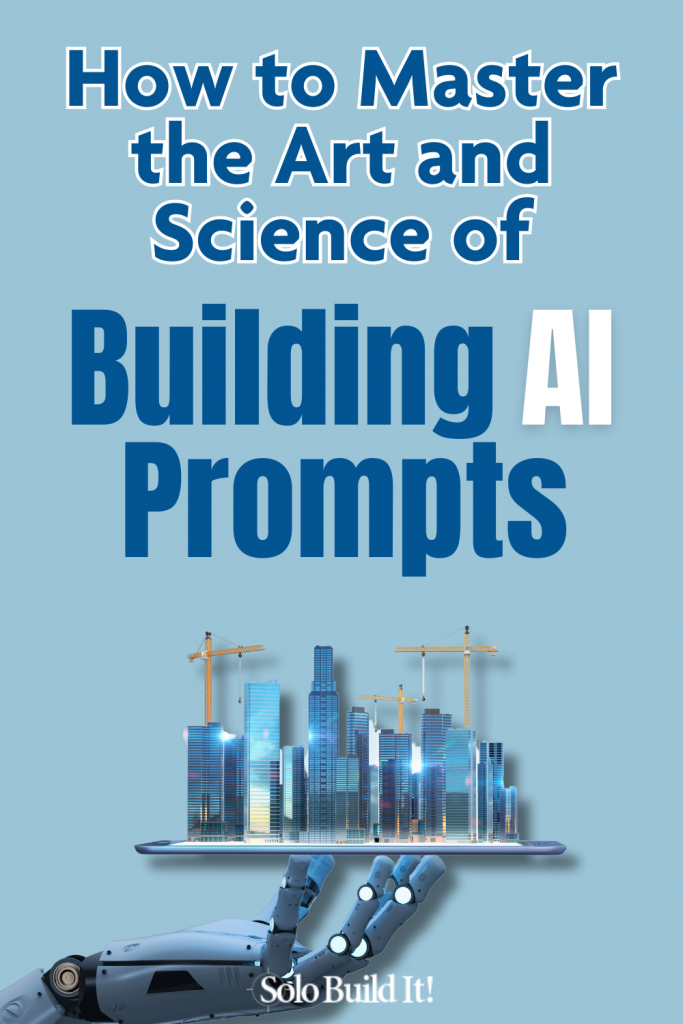 Purpose: The purpose of the page is to present Anguilla’s beaches, which is its top attraction, favorably and lovingly so that prospective tourists decide to make their next vacation in Anguilla.
Purpose: The purpose of the page is to present Anguilla’s beaches, which is its top attraction, favorably and lovingly so that prospective tourists decide to make their next vacation in Anguilla.
Profile: The target market is prospective tourists, higher-end socioeconomically, with discriminating tastes, 35 to 65 years old, who travel quite a bit, taking at least one winter vacation per year to warmer climes.
People who search for “Anguilla beaches” are either researching or planning a vacation to Anguilla. They want to know how good the beaches are (compared to other destinations), which are best for swimming and other water activities, which have the best beach bars and restaurants, which have the best high-end hotels.
Page Length: At least 1200 words, a highly detailed discussion of Anguilla’s beaches, especially its top five beaches and what makes them so popular (e.g., restaurants, hotels, quality of the beach itself, things to do).
Combine the ultimate tropical getaway with a luxury vacation that features:
- the world’s best sandy shorelines (as voted in major travel magazines)
- its culinary competition-winning, 5-star dining
- its safety and warm, friendly people
Personality:
- Style: The style of the writing must be relaxed, engaging, conversational and friendly.
- Tone: The tone of the writing must be inviting, enthusiastic and optimistic. Paint a picture of a vibrant, exciting and luxurious destination.
- Voice: The voice of the writing must be active, with the author speaking directly to the reader.
- Reading Level: The reading level of the writing must be approximately 8th grade level.
- Readability: The writing must be easy to understand and follow.
Preconditions: The competition among Caribbean islands for winter-vacationing tourists, who are high-end and discriminating, is fierce. This page must emphasize Anguilla’s uniqueness and stand out because of its high value and the style with which it’s delivered.
Pertinent Connections: Keywords are words or short phrases that we want to rank highly for at Google. Include the primary keyword “Anguilla beaches.” And include these two secondary keywords — “Anguilla vacation” and “Anguilla beach vacation.”
These sentiments are related to Anguilla — Caribbean, vacation, safe exploration, white sand, sunshine, desert island, relaxation, tranquility wrapped in blue, snorkeling, sandy shores, relaxation retreat, fine dining experiences, luxury travel experience, crystal clear waters, peaceful serenity, warm and friendly people.
Tip: Once you know the primary and secondary keywords of each page, use Tai Freestyle to brainstorm more related sentiments. Here’s how…
Brainstorming keywords that are related to the topic is usually not very productive for this purpose…
These three brainstorm-prompts work better…
- Exclude the generic word, “Anguilla.”
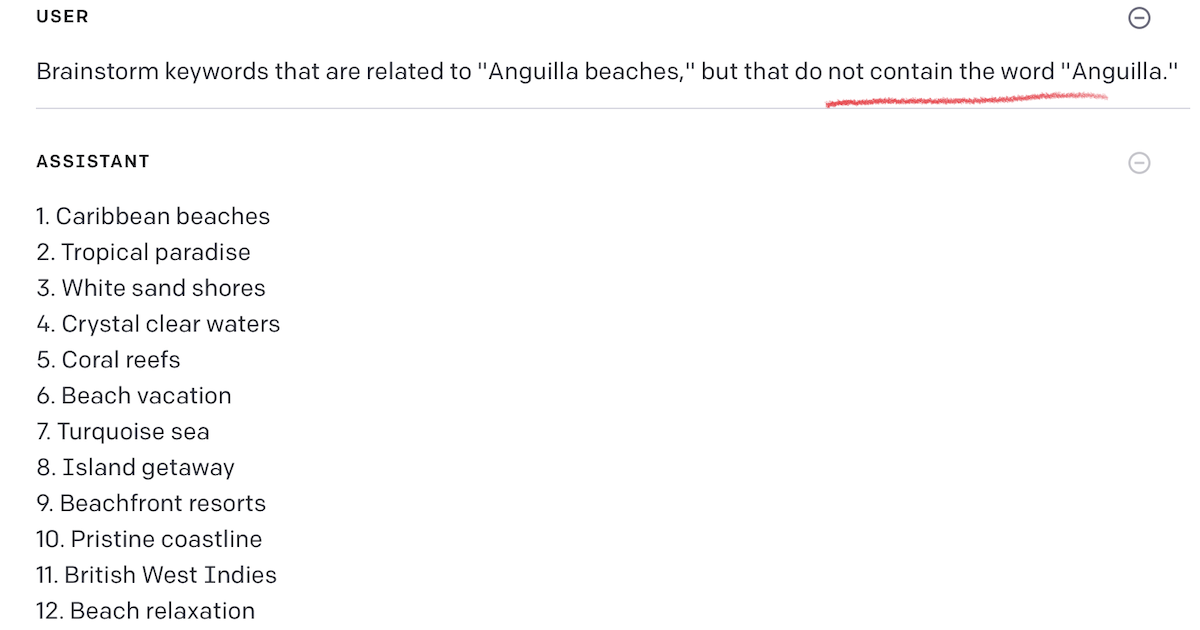
- Brainstorm on sentiments rather than on keywords…
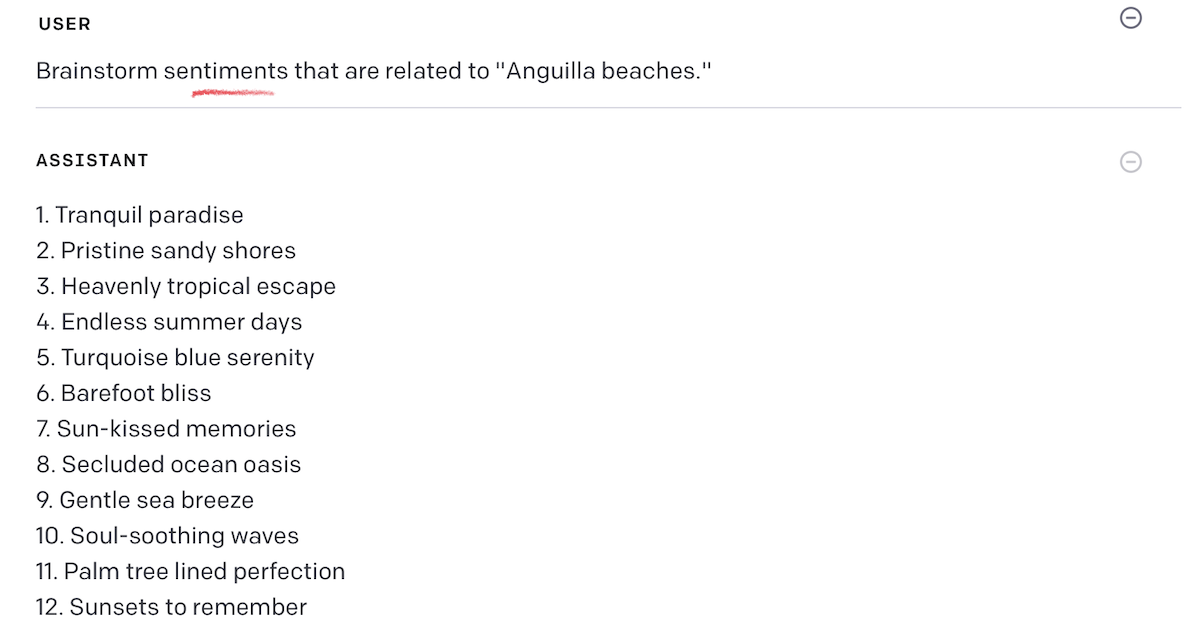
- Instead of the word “brainstorm,” use the more general word develop…
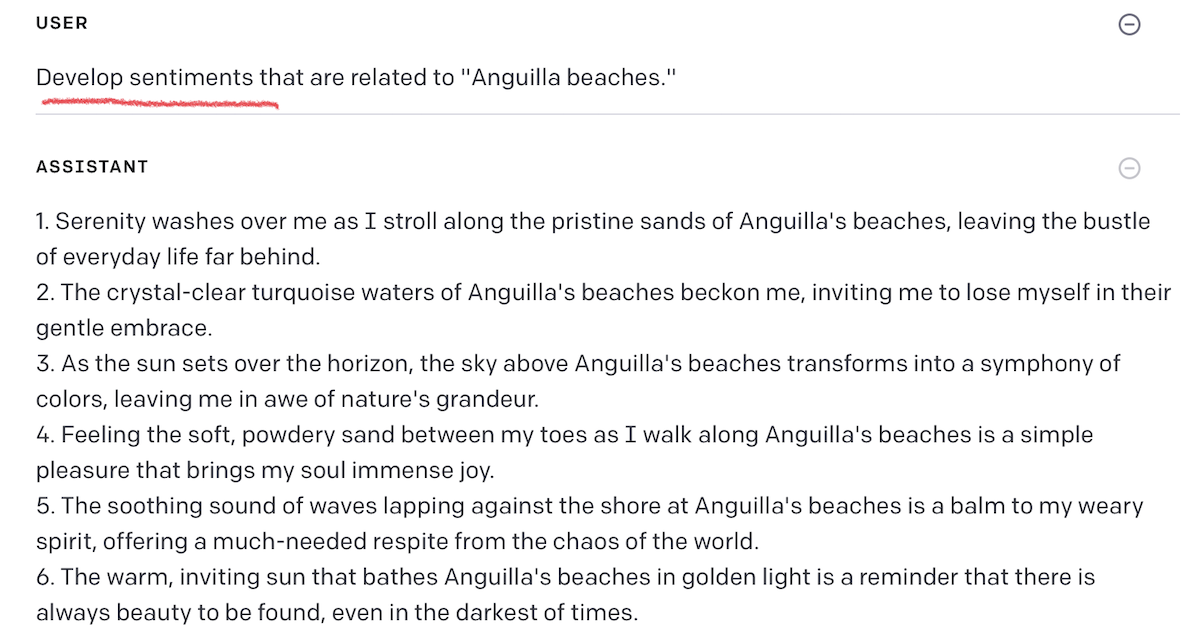
Each of the above generates much more than is shown in the screenshots. There’s enough here for you to pick and choose the best sentiments that really feel like the topic. Be creative — there are so many stimulating ideas for you to play with and find even better feelings to include.
The final step? After you’ve completed the above, edit it all down to a single, long paragraph. Check it against the 🐝🐝🐝🐝🐝🐝. For example, eliminate redundancies, vagueness, etc. Set Tai’s length to maximum.
Give it one final read. Does it provide an excellent idea of what you want to get back from Tai? If so, you’re good to go!
And so is Tai.
Tai’s Prompt Build It! makes the prompt-building process faster and foolproof. It also includes some programming to make the prompt even better.
Even when you use it well, a better prompt may exist for the particular topic you want to cover. That’s why we created the Community Prompt Library.
Also, it can be tricky designing effective prompts at first. In fact, when you hear someone complain that they didn’t get much out of ChatGPT or other GAI systems, you can bet that it’s the prompt that was lacking, not the A.I.
Prompt Build It! “trains you as you go,” assuring high value prompts right from the start, ready to let you go (if you want) once you have the hang of it.
But there’s another way to ensure you use the best quality prompts. Borrow the winning prompt of someone else. Here’s how that happens…
All Tai users save their best prompts to the Community Prompt Library, outlining how they used them, for others to try. Others search the library and review the prompts, implementing the one that fits their needs best, then scoring it (on a scale of 1 to 10).
Everyone scores and reviews each other’s prompts. So over time, the best rise to the top (there will be Tai credit prizes for the most used and highly scored prompts).
We’ve stocked the library with over 1,000 winning prompts. It will grow quickly after we launch.
Bottom Line
We’re all in this together, helping each other get the most out of Tai, getting better at creating stronger and better content.
In Part 7, I go into the productivity increases you can expect from using Tai to help you create content for your business.
If you’ve missed some of the parts of this series, they’re available here.
By the way, if you have questions or comments, leave them below. I read them all and will answer many.
Ditto for using A.I. to grow an online business. Is there a topic that I haven’t covered? Let me know how you would like me to extend the series. I’m all 👂s!
Until we meet again, be great.
Images by DALL-E and Midjourney

